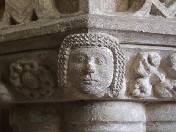| |
|
All
Saints, Kirby Cane
 |
|
The
first time I ever visited Kirby Cane church, it
was in the middle of the night. We were driving
past, taking the narrow country lanes between
Norwich and Bungay. We came over a rise, and the
round tower loomed up before us in the moonlight.
I remember getting out and wandering up the path
under the dark spreading canopy of the
magnificent spruce trees. It was like walking
into a Gothick horror story. Kirby Cane
parish contains the sizeable village of Kirby
Row, but the church and churchyard are some way
off on the other side of the Diss to Yarmouth
road. In daylight this is a rather charming spot,
although the trees are still magnificent. I can't
think of any bigger in a Norfolk graveyard than
the one near the gate. The graveyard itself is
small, and pleasingly random.
|
And All
Saints is a small church, the tower to scale. Its age is
revealed by the beautiful Norman south doorway, a common
feature around here in this area of small parishes with
small churches, although Sam Mortlock points out that
this one has an outer ring of decoration which is unique
in the county. The door is a little fiddly - you have to
get the handle of the latch just right - but you
step into a well-maintained interior which is full of
light. There is a beautiful roodloft stairway set in the
splay of the window on the south side.
| The
font is a fine example from the 14th century.
It's traceried panels were probably painted once,
and the heads peering from beneath the bowl are
all different. The font cover remembers the
Coronation of Edward VII, the first there had
been of a British monarch in 65 years.The royal
arms and a pair of hatchments on the west wall
have been restored splendidly - they look almost
new - and, indeed, one of them is 20th Century,
one of the very last in England. The
furnishings are simple and seemly; the chancel,
with its Restoration period communion rails. is
elegant in its simplicity. It is all thoroughly
fitting for modern Anglican worship. The glass in
the east window is stretched to create a
shimmering effect, with a single panel of
heraldic glass in the middle. On the north side
of the chancel is a blocked archway, once that to
a chapel, with a tombchest set against it. Can it
once have been an Easter sepulchre? It seems hard
to believe that it is in its original place.
A
curiosity is the brass plaque on the chancel
floor inscribed in an amateur hand. It tells us
that Here lieth the body of John Watson
Rector of Kirby Cane who died January 5th Ano Do
MDMV - presumably it means MDCV, that is to
say 1605. It ends with words which I cannot
decode.
|
|
 |
|
|
|
